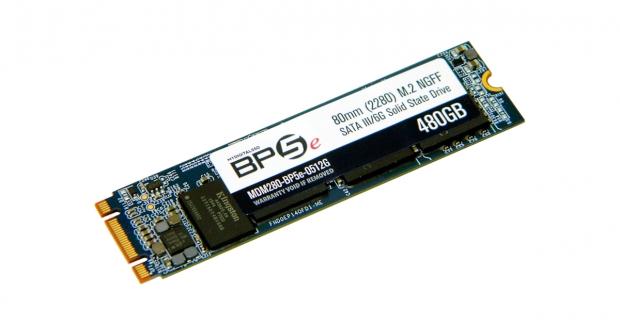
The Bottom Line
Introduction, Drive Specifications, Pricing and Availability

Phison's PS3110-S10-X quad-core 8-channel controller (or S10) has emerged as the leading third-party SATA III controller on the market. More than that, though, it has emerged as a TweakTown favorite. Whether the S10 is paired with MLC or TLC flash, you can expect class-leading sequential performance. As we all know, sequential performance has a great impact on the end-user's overall SSD experience.
The MDD BP5e M.2 x2280 SATA III SSD we have on the bench today carries the same factory specifications as the 2.5" x 7mm cased model we previously reviewed. We mention this because we've seen reviews floating around on the internet showing the M.2 model as a significantly lower performing piece of hardware in comparison to the 2.5" cased model. We don't know how those reviewers arrived at that conclusion, but we will state up front that M.2 version performs just as well as the cased model.
The most appealing thing about MDD's BP5e series SSDs other than performance is a low price point. The 480GB BP5e M.2 SSD we are testing today is priced much more affordably than Samsung's 850 EVO 500GB M.2 SSD. Current pricing has the 850 EVO 500GB M.2 selling for $179.99, the BP5e 480GB M.2 for a mere $121.87; or about 60 bucks cheaper. MDD's BP5e M.2 isn't quite as fast as Samsung's 850 EVO equivalent, but we feel what the BP5e lacks in performance by comparison is more than made up for in terms of pricing. Both SSDs deliver for the most part a similar SSD experience. You get a bit more capacity from the EVO (20GB), but you will pay a lot more for an EVO. That said, we don't believe the 850 EVO and the BP5e are competitors for market share because of the price difference between them. This is why we are not comparing the two in our review.
MDD's BP5e 480GB M.2 SATA III SSD pairs Phison's S10 8-channel quad-core controller with Toshiba's 15nm 3bit (TLC) flash for a low-cost solution that still delivers high performance. We like the choice of Toshiba's 15nm TLC flash because it has proven to be better performing than 16nm Micron TLC and 16nm Hynix TLC. One of the reasons we like Phison S10-controlled SSDs when paired with TLC flash is that the S10 employs direct-to-die write. This means that instead of continually filling up the pSLC (pseudo-SLC) layer and then flushing to the NAND array, S10-powered SSDs write straight to the flash array once the fast pSLC layer is filled. This results in much better sustained write performance for planar-based TLC SSDs.
As we've stated on numerous occasions, any SSD we test must deliver at least a 200 MB/s sustained write transfer rate with our transfer testing to receive a TweakTown recommendation. This is because we feel adamant that an SSD must deliver sustained write performance that at the very least is comparable to that of a high-performance mechanical HDD. You may be under the impression that typical factory write specifications of 500 MB/s tell the whole story, but they do not. In the case of planar-based SSDs, that is just burst performance not sustained write transfer performance. Sustained write performance comes into play very often for most users when performing everyday tasks like installing games or transferring large blocks of data from one drive to another. There are a whole host of planar TLC SSDs that can only muster a 100 MB/s sustained write transfer rate.
Let's take a close at MDD's BP5e 480GB M.2 SATA III SSD.
Specifications
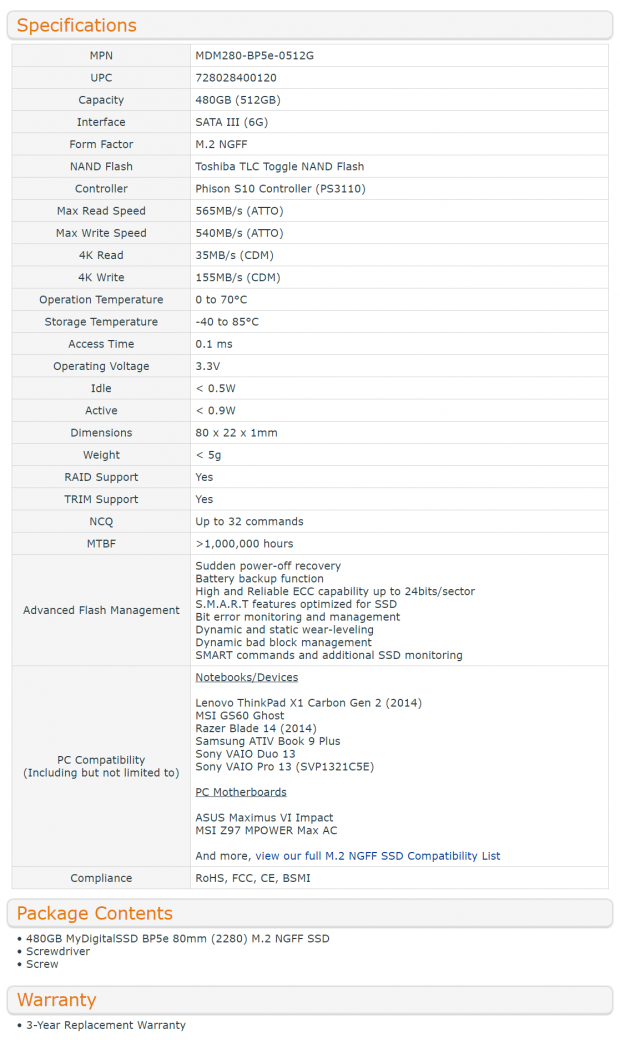
MDD's M.2 x2280 SATA III SSD is available in three capacities: 120GB, 240GB, and 480GB. The 480GB model we have on the bench has the following factory specifications:
Sequential Read: up to 565 MB/s (ATTO). Sequential Write: up to 540 MB/s (ATTO). 4K QD1 Random Read Speed: 35 MB/s (CDM). 4K QD1 Random Write Speed: 155 MB/s (CDM).
The retail package includes a handy screwdriver and mounting screw. MDD backs the BP5e with a three-year replacement warranty. MDD does not list a TBW (Total Bytes Written) limit during the three-year warranty period. MDD's BP5e 480GB M.2 SATA III SSD is currently selling for $121.87 at My Digital Discount.
Drive Details
MDD BP5e 480GB M.2 SATA III SSD
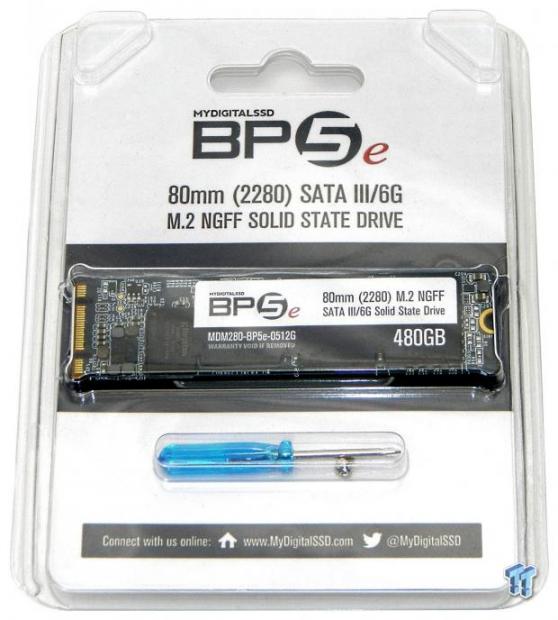
MDD's BP5e M.2 x2280 ships in a clear plastic blister pack that includes a handy screwdriver and mounting screw. The front of the packaging lists the drive's model and form factor. The capacity of the drive is visible on the drive's manufacturer label.
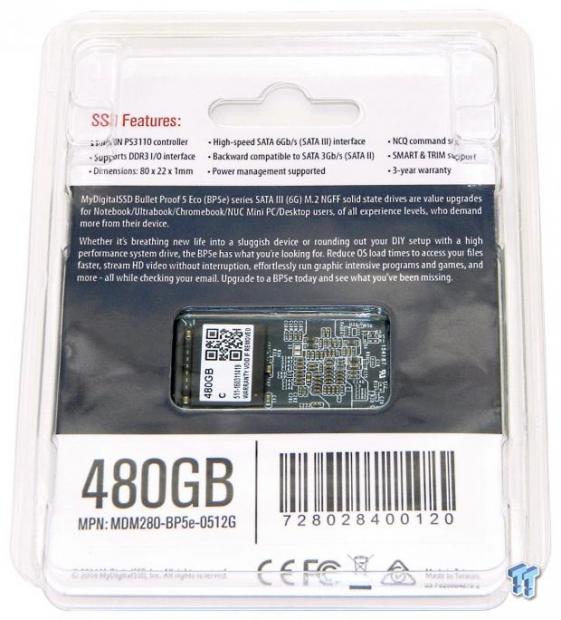
Looking at the back of the blister pack, we can see a features list for the enclosed SSD. The three-year warranty is advertised as well as the drive's capacity.

This half of the drive's PCB features a manufacturer label. The label lists the drive's capacity, model number, form factor, and SATA III/6Gbit interface.

This half of the PCB houses two 128GB flash packages. One of the flash packages has a label on it that if removed will void the drive's warranty.

With the manufacturer label removed, we can see that this half of the PCB houses two 128GB flash packages, Phison S10 controller, and a single DRAM cache package.
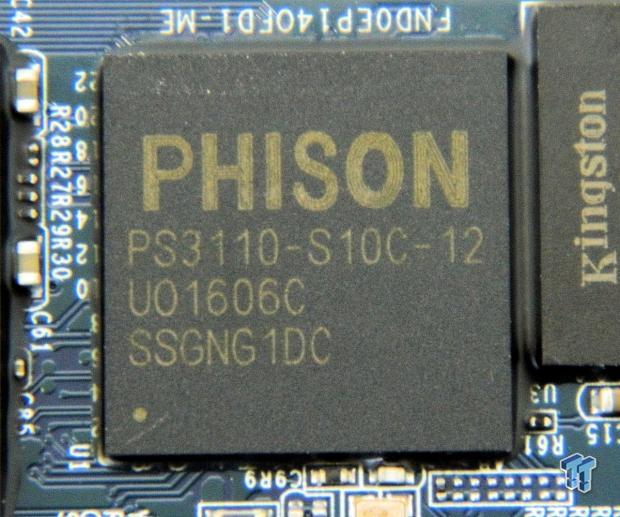
A detailed view of the drive's Phison PS3110 (S10) 8-channel quad-core controller.
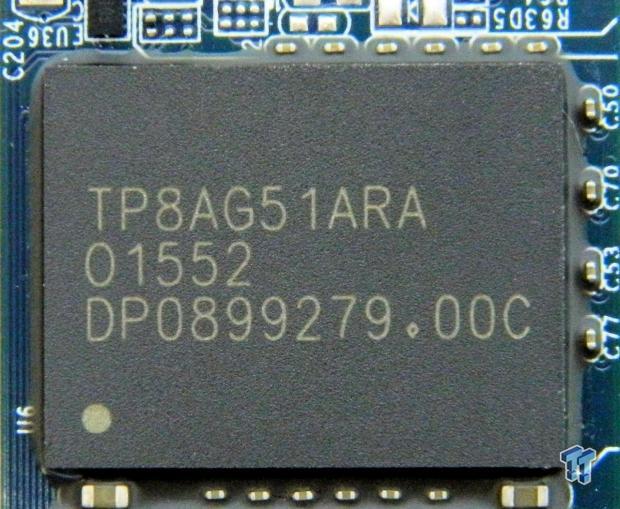
A detailed view of one of the drive's four 128GB Toshiba 15nm TLC flash packages.
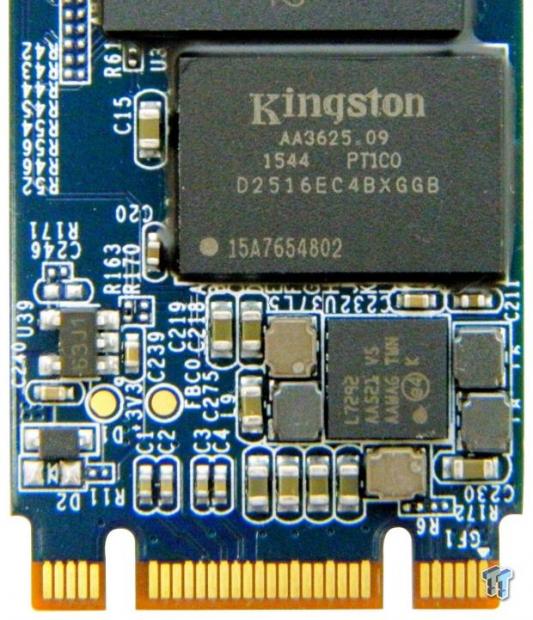
A detailed view of the drive's edge connector and 512MB Kingston 1600MHz DDR3 DRAM cache package.
Test System Setup and Properties
Jon's Consumer SSD Review Test System Specifications
- Motherboard: ASRock Extreme9 Z97 - Buy from Amazon
- CPU: Intel Core i7 4790K @ 4.8GHz - Buy from Amazon / Read our review
- Cooler: Swiftech H2O-320 Edge - Buy from Amazon / Read our review
- Memory: Corsair Dominator DDR3 32GB 2400MHz - Buy from Amazon
- Video Card: Onboard Video
- Case: IN WIN X-Frame - Buy from Amazon / Read our review
- Power Supply: Seasonic Platinum 1000 Watt Modular - Buy from Amazon / Read our review
- OS: Microsoft Windows 10 Professional 64-bit - Buy from Amazon
- Drivers: Intel RAID option ROM version 13.0.0.2075 and Intel RST driver version 13.6.0.1002
We would like to thank ASRock, Crucial, Intel, Corsair, RamCity, IN WIN, and Seasonic for making our test system possible.
Drive Properties
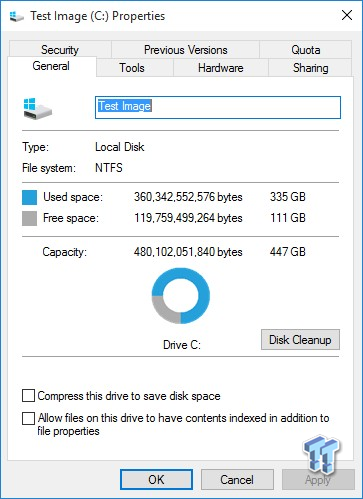
The majority of our testing is performed with our test drive as our boot volume. Our boot volume is 75% full for all OS Disk "C" drive testing to replicate a typical consumer OS volume implementation. We feel that most of you will be utilizing your SSDs for your boot volume and that presenting you with results from an OS volume is more relevant than presenting you with empty secondary volume results.
System settings: Cstates and Speed stepping are both disabled in our systems BIOS. Windows High-Performance power plan is enabled. Windows write caching is enabled, and Windows buffer flushing is disabled. We are utilizing Windows 10 Pro 64-bit OS for all of our testing except for our MOP (Maxed-Out Performance) benchmarks where we switch to Windows Server 2008 R2 64-bit.
Synthetic Benchmarks - ATTO & Anvil Storage Utilities
ATTO
Version and / or Patch Used: 2.47
ATTO is a timeless benchmark used to provide manufacturers with data used for marketing storage products.
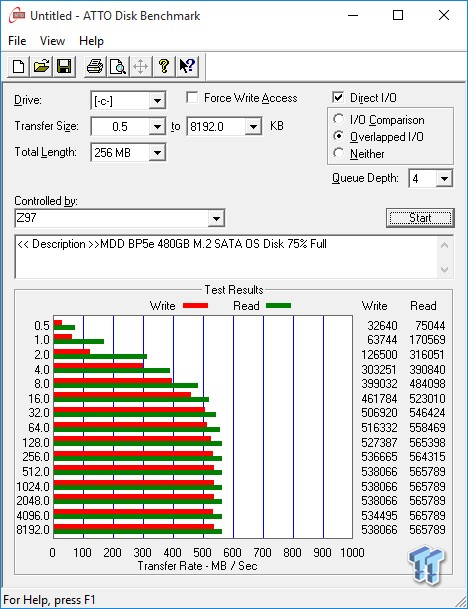
Compressible sequential read/write transfers max out at 565/538 MB/s. Keep in mind this is our OS volume, and it is filled to 75% of its total capacity. Maximum sequential read performance is achieved at a 512KB transfer size, maximum sequential write performance also at 512KB transfers.
Sequential Write
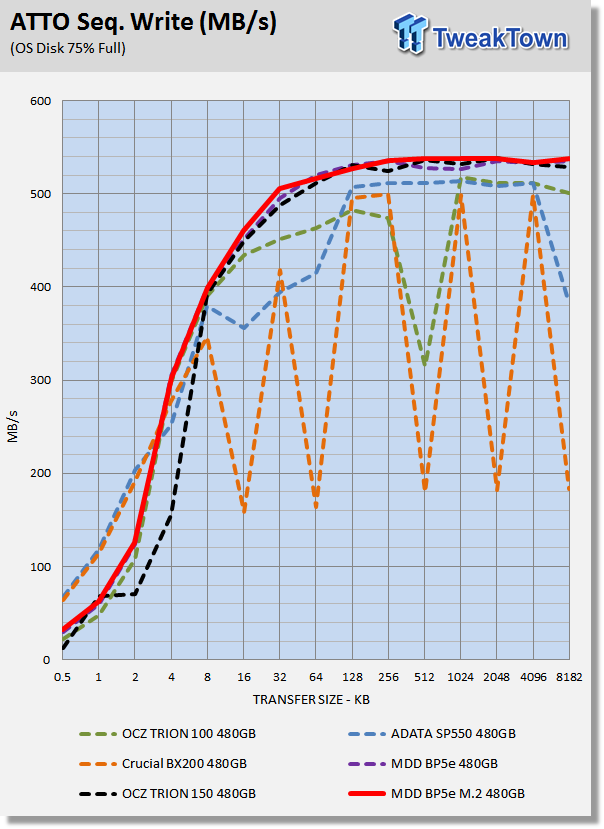
Overall, the BP5e M.2 delivers the best performance, slightly better than the cased BP5e 480GB. The BX200 and SP550 display choppy write performance due to their SM2256 controllers.
Sequential Read
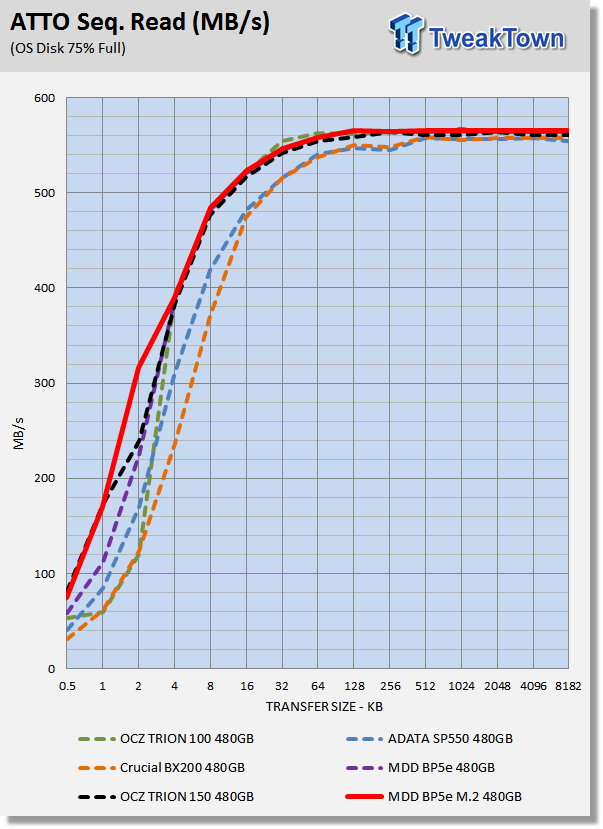
Again, the M.2 BP5e delivers the best performance of the drives in our test pool. We note the M.2 BP5e delivers better small file performance than the cased model.
Anvil Storage Utilities
Version and / or Patch Used: 1.1.0
Anvil's Storage Utilities is a storage benchmark designed to measure the storage performance of SSDs. The Standard Storage Benchmark performs a series of tests; you can run a full test or just the read or write test, or you can run a single test, i.e. 4k QD16.
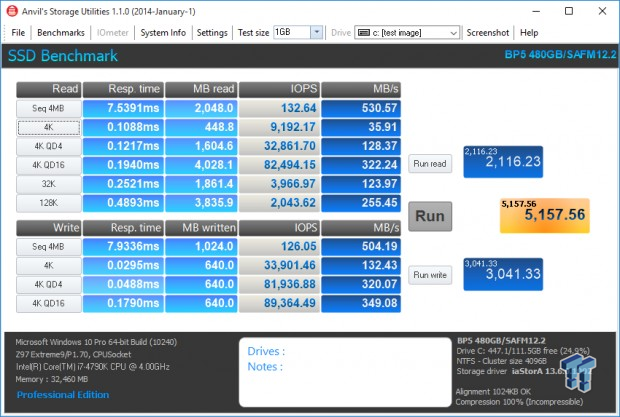
Scoring
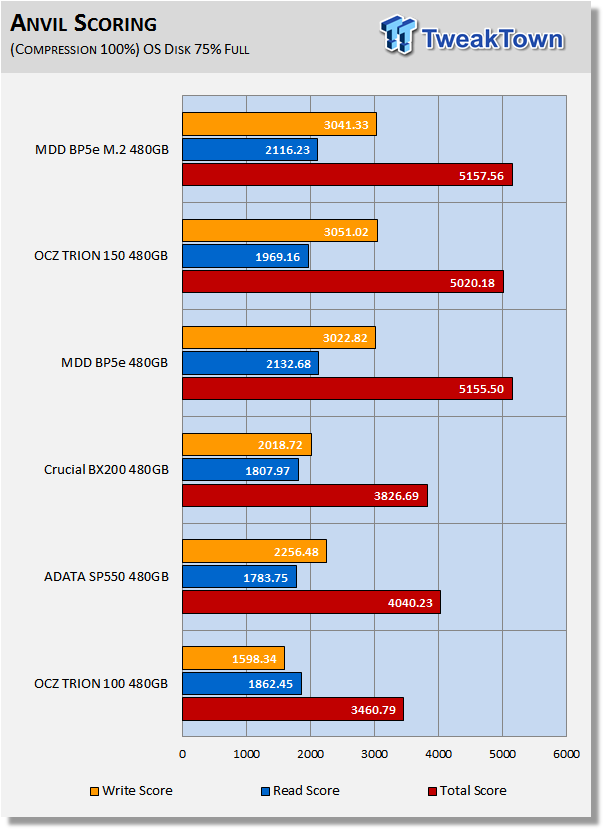
Anvil's scoring gives a good indication of a drive's overall performance. MDD's BP5e M.2 scores well over 5000 which is always a good indication that a drive is capable of delivering top-notch everyday performance. The M.2 BP5e manages to outscore the cased model. All of the S10-powered drives except the TRION 100 score over 5000. The SM2256 powered SSDs (SP550 & BX200) are clearly overmatched in this test.
(Anvil) Read IOPS through Queue Depth Scale
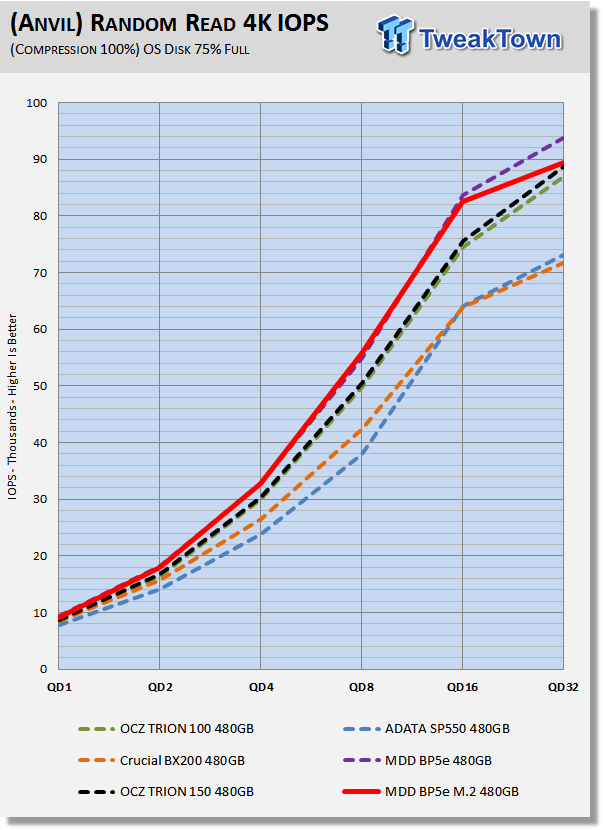
The M.2 BP5e and the cased model both deliver similar performance up to QD16. The cased model wins out at QD32. Both versions outperform the field.
(Anvil) Write IOPS through Queue Scale
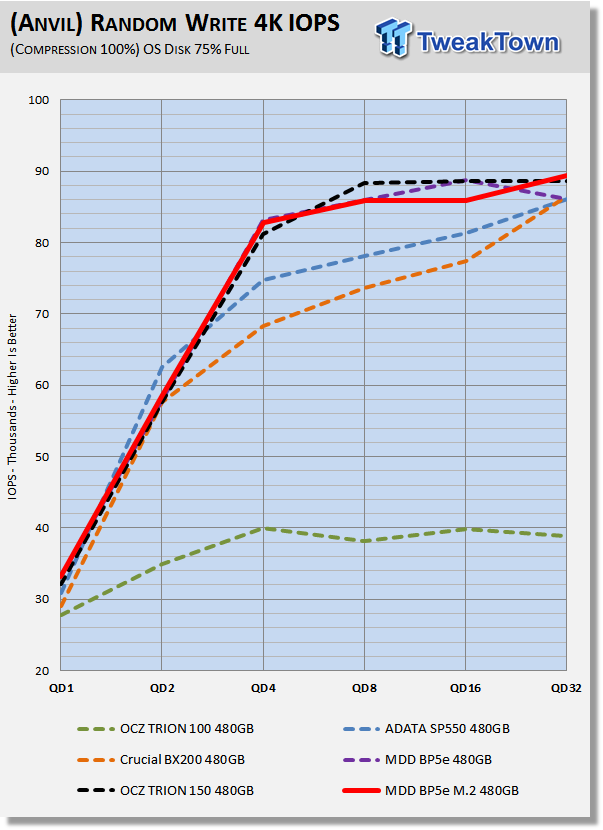
The BP5e's deliver the best QD1 performance of the bunch. ADATA's SP550 takes the lead at QD2 but quickly drops away from the S10-powered BP5e's and OCZ's TRION 150 at higher queue depths. OCZ's TRION 150 delivers the best overall performance.
Synthetic Benchmarks - CrystalDiskMark & AS SSD
CrystalDiskMark
Version and / or Patch Used: 3.0 Technical Preview
CrystalDiskMark is disk benchmark software that allows us to benchmark 4k and 4k queue depths with accuracy. Note: Crystal Disk Mark 3.0 Technical Preview was used for these tests since it offers the ability to measure native command queuing at QD4.
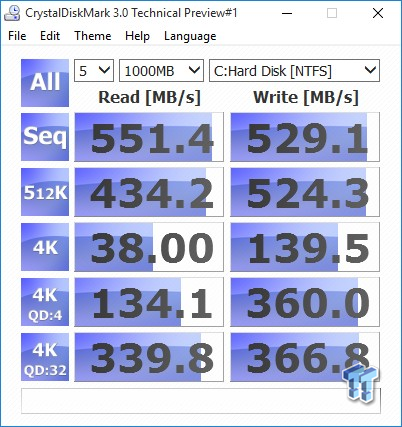

When it comes to sequential performance, S10-powered drives set the bar. We also note the superior performance of the BP5e at QD1 and QD4. The cased model delivers the best performance of the bunch at QD32.
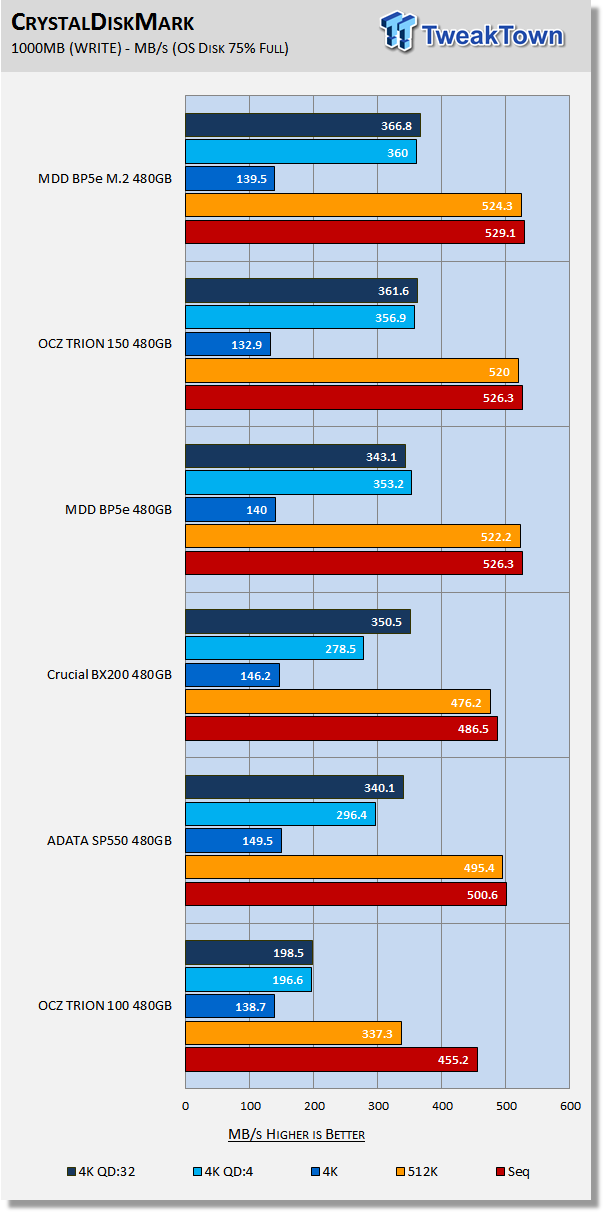
MDD specs the BP5e at up to 155 MB/s with CDM at 4K QD1 write. This spec is accurate, but only for Windows 7 users. Windows 8.1 or 10 users can expect about 140 MB/s if their system is well tuned.
AS SSD
Version and / or Patch Used: 1.7.4739.38088
AS SSD determines the performance of SSDs. The tool contains four synthetic as well as three practice tests. The synthetic tests are to determine the sequential and random read and write performance of the SSD.
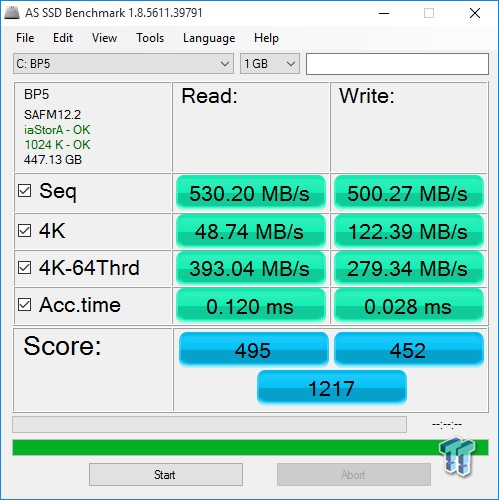
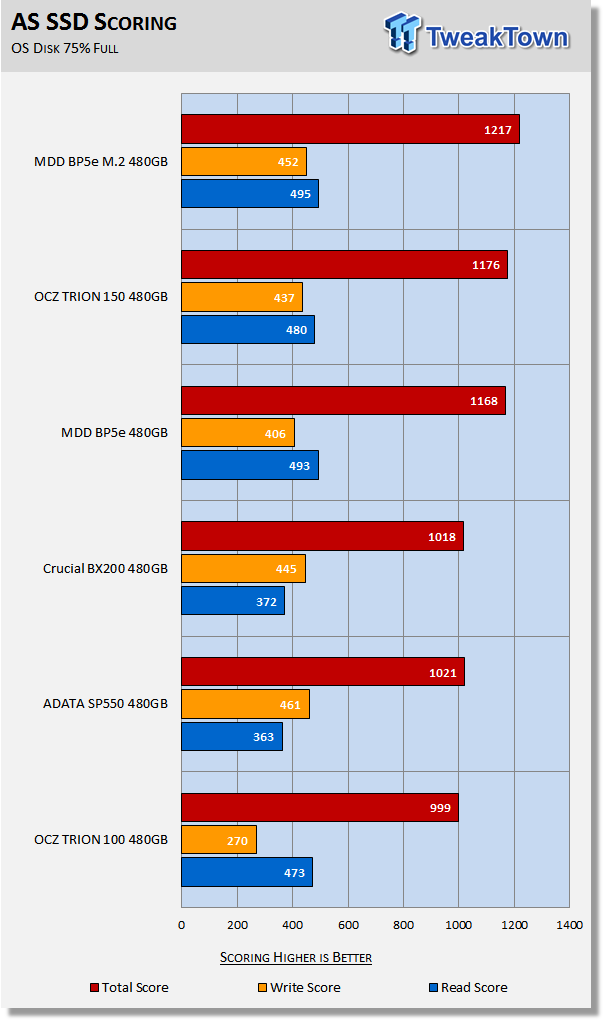
AS SSD is a demanding test, and the MDD BP5e M.2 does not disappoint. In fact, it sets a new lab record for planar TLC SSDs. Like we stated in our intro, the M.2 version of the BP5e is just as fast as the cased model; contrary to some published reviews floating around out there.
Benchmarks (Trace-Based OS Volume) - PCMark Vantage, PCMark 7 & PCMark 8
Moderate Workload Model
We categorize these tests as indicative of a moderate workload environment.
PCMark Vantage - Hard Disk Tests
Version and / or Patch Used: 1.2.0.0
The reason we like PCMark Vantage is because the recorded traces are played back without system stops. What we see is the raw performance of the drive. This allows us to see a marked difference between scoring that other trace-based benchmarks do not exhibit. An example of a marked difference in scoring on the same drive would be empty vs. filled vs. steady state.
We run Vantage three ways. The first run is with the OS drive 75% full to simulate a lightly used OS volume filled with data to an amount we feel is common for most users. The second run is with the OS volume written into a "Steady State" utilizing SNIA's guidelines. Steady state testing simulates a drive's performance similar to that of a drive that been subjected to consumer workloads for extensive amounts of time. The third run is a Vantage HDD test with the test drive attached as an empty, lightly used secondary device.
OS Volume 75% Full - Lightly Used
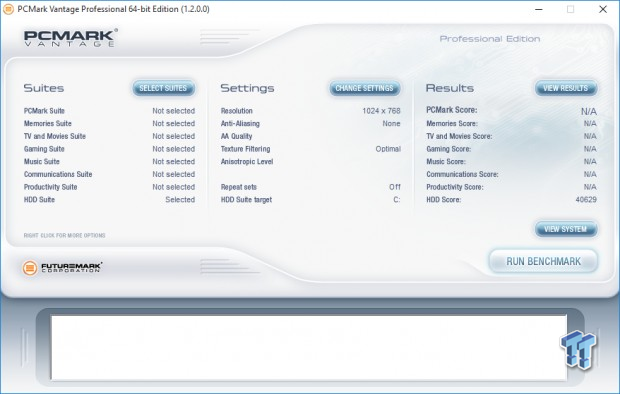
OS Volume 75% Full - Steady State
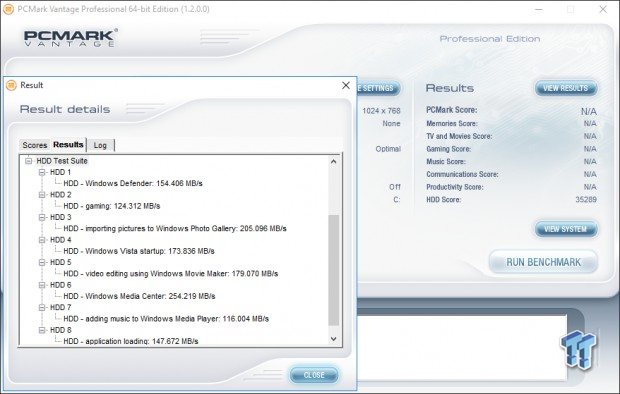
Secondary Volume Empty - FOB
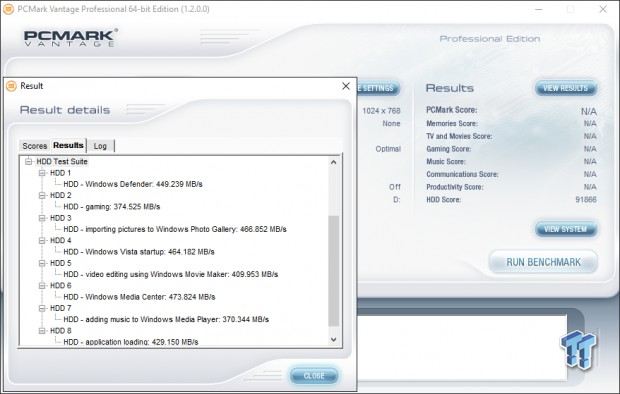
There's a big difference between an empty drive, one that's 75% full/used, and one that's in a steady state.

The important scores to pay attention to are "OS Volume Steady State" and "OS Volume 75% full." These two categories are most important because they are indicative of typical of consumer user states. When a drive is in a steady state, it means garbage collection is running at the same time it's reading/writing. This is exactly why we focus on steady state performance.
We consider 40K with a drive 75% full to be the minimum score we want to see from a planar TLC SSD. The BP5e M.2 achieves this benchmark score. Our only knock against S10-powered SSDs has been and continues to be moderate workload performance. The SM2256-powered drives typically fare better than S10-powered SSDs with moderate workloads. However, this is not enough to make up for their abysmal synthetic performance and awful sustained write transfer rates.
PCMark 7 - System Storage
Version and / or Patch Used: 1.4.0
We will look to Raw System Storage scoring for evaluation because it's done without system stops and, therefore, allows us to see significant scoring differences between drives.
OS Volume 75% Full - Lightly Used
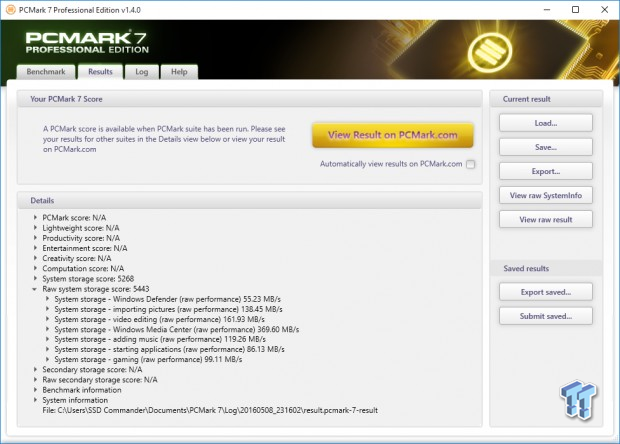
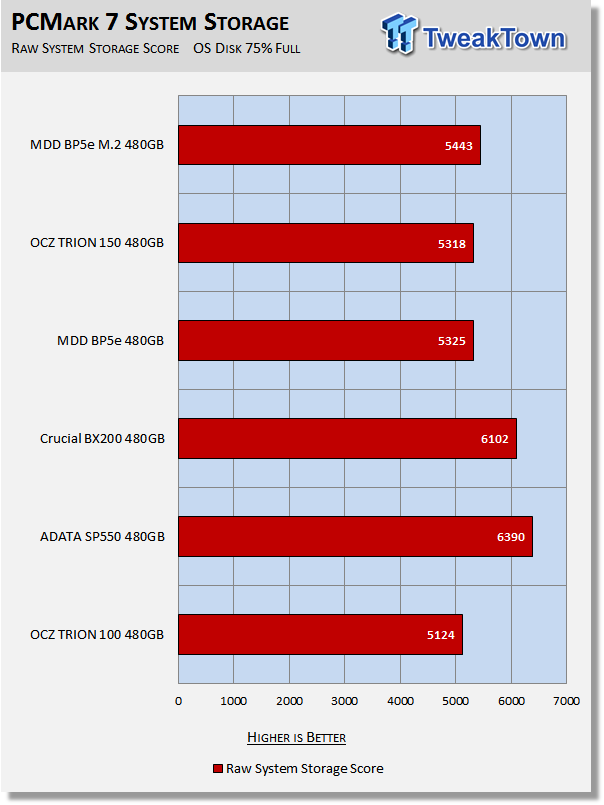
Here again, the M.2 BP5e outperforms all of the S10-powered SSDs in our test pool. This is additional proof that the M.2 BP5e is every bit as fast as the cased model.
PCMark 8 - Storage Bandwidth
Version and / or Patch Used: 2.4.304
We use PCMark 8 Storage benchmark to test the performance of SSDs, HDDs, and hybrid drives with traces recorded from Adobe Creative Suite, Microsoft Office, and a selection of popular games. You can test the system drive or any other recognized storage device, including local external drives. Unlike synthetic storage tests, the PCMark 8 Storage benchmark highlights real-world performance differences between storage devices.
OS Volume 75% Full - Lightly Used
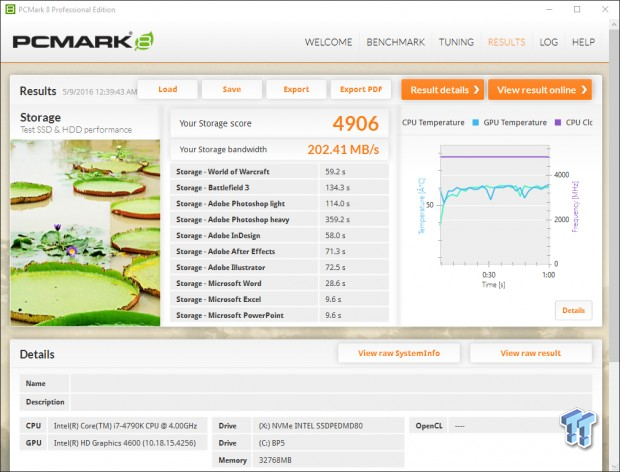
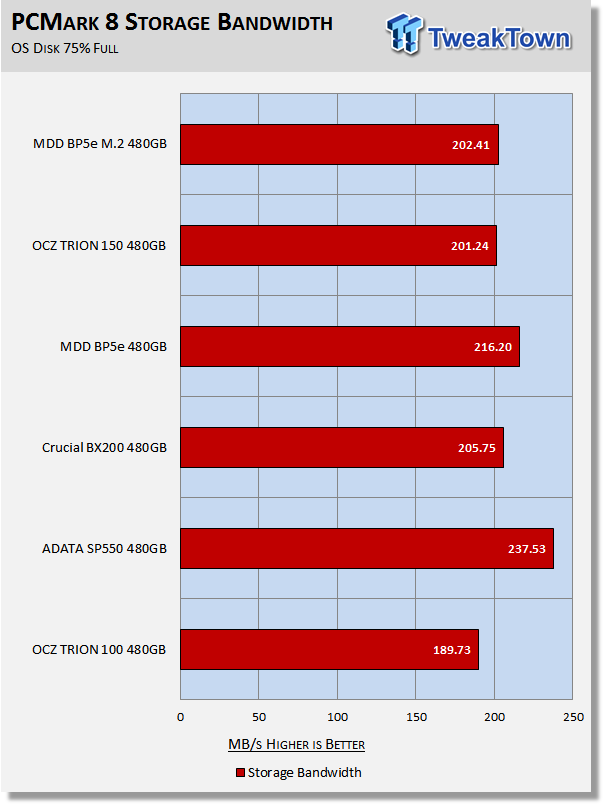
PCMark 8 is the most intensive moderate workload simulation we run. With respect to moderate workloads, this test is what we consider the best indicator of a drive's performance. ADATA's SP550 wins this test. The cased BP5e fares a bit better than the M.2 version in this testing.
Benchmarks (Secondary) - Max IOPS, Response & Transfer Rates
Iometer - Maximum IOPS
Version and / or Patch Used: Iometer 2014
We use Iometer to measure high queue depth performance. (No Partition)
Max IOPS Read
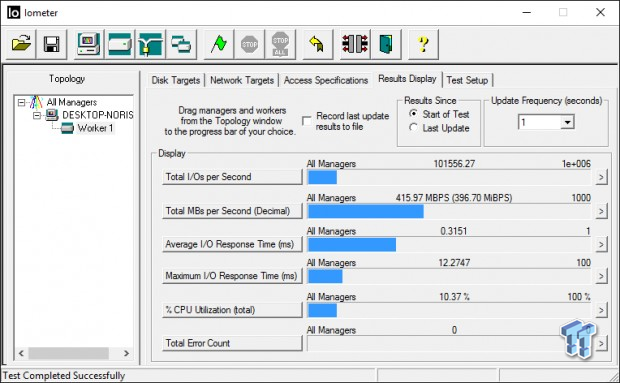
Max IOPS Write
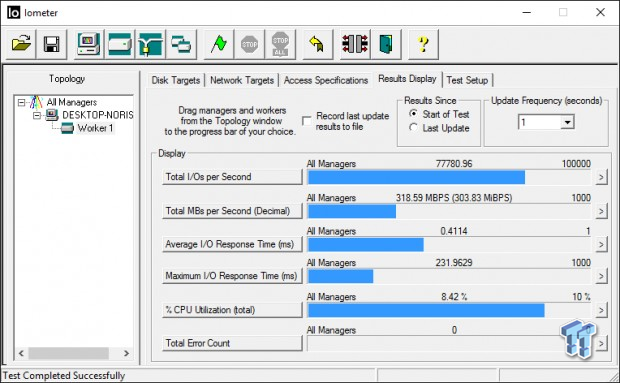

MDD doesn't list factory max random performance specifications. We can tell you to expect about 78K write and 101K read. The M.2 BP5e delivers the best random write performance of the drives in our test pool.
Iometer - Disk Response
Version and / or Patch Used: Iometer 2014
We use Iometer to measure disk response times. Disk response times are measured at an industry accepted standard of 4K QD1 for both write and read. Each test runs twice for 30 seconds consecutively, with a 5-second ramp-up before each test. We partition the drive/array as a secondary device for this testing.
Avg. Write Response
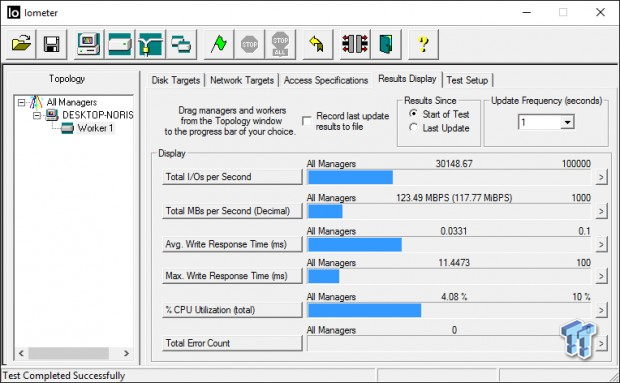
Avg. Read Response
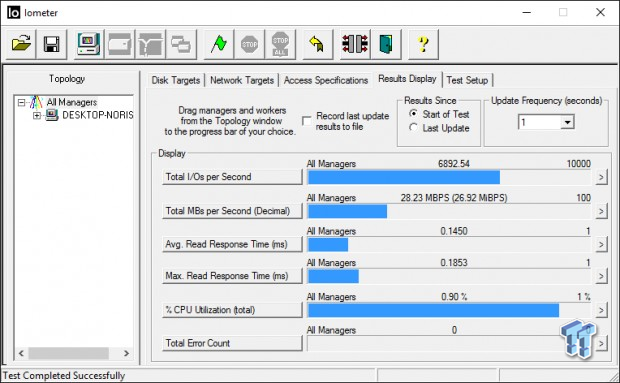
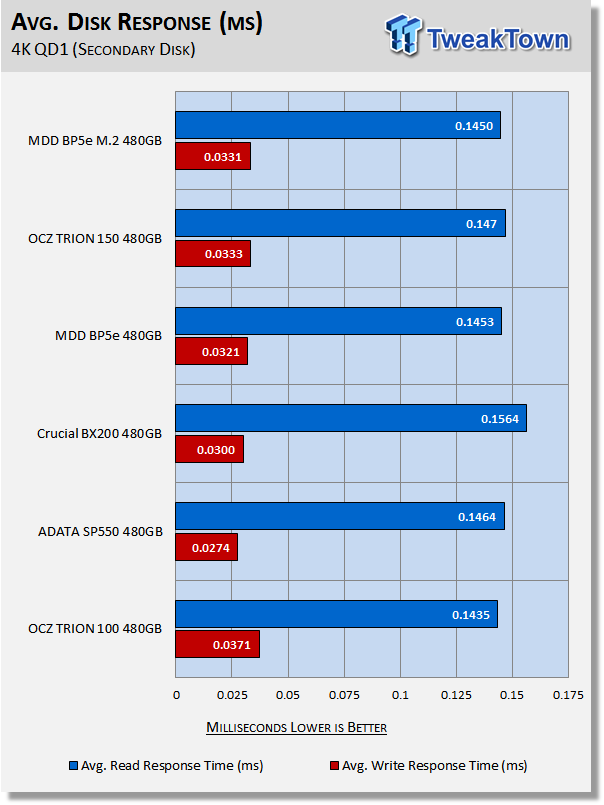
The cased BP5e has slightly better (lower) write response than the M.2 model. The reverse is true for read response. ADATA's SP550 delivers the best write response of the bunch.
DiskBench - Directory Copy
Version and / or Patch Used: 2.6.2.0
We use DiskBench to time a 28.6GB block (9,882 files in 1,247 folders) composed primarily of incompressible sequential and random data as it's transferred from our DC P3700 PCIe NVME SSD to our test drive. We then read from a 6GB zip file that's part of our 28.6GB data block to determine the test drive's read transfer rate. Our system is restarted prior to the read test to clear any cached data, ensuring an accurate test result.
Write Transfer Rate
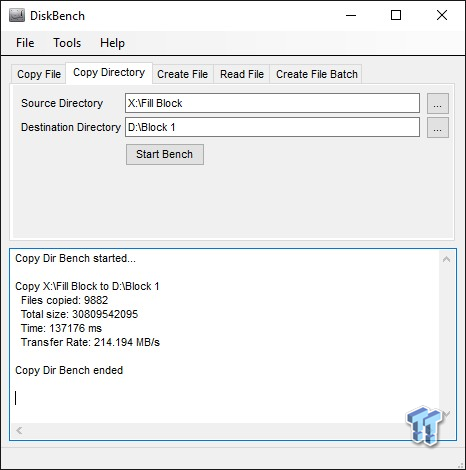
Read Transfer Rate
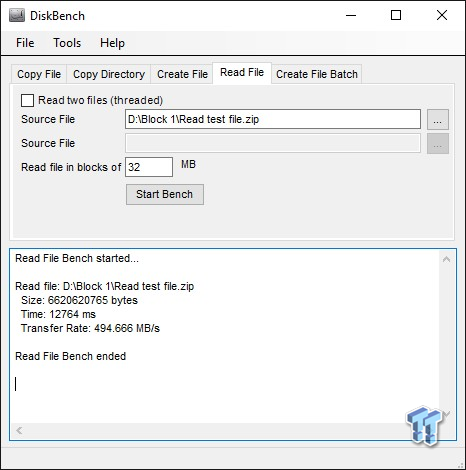
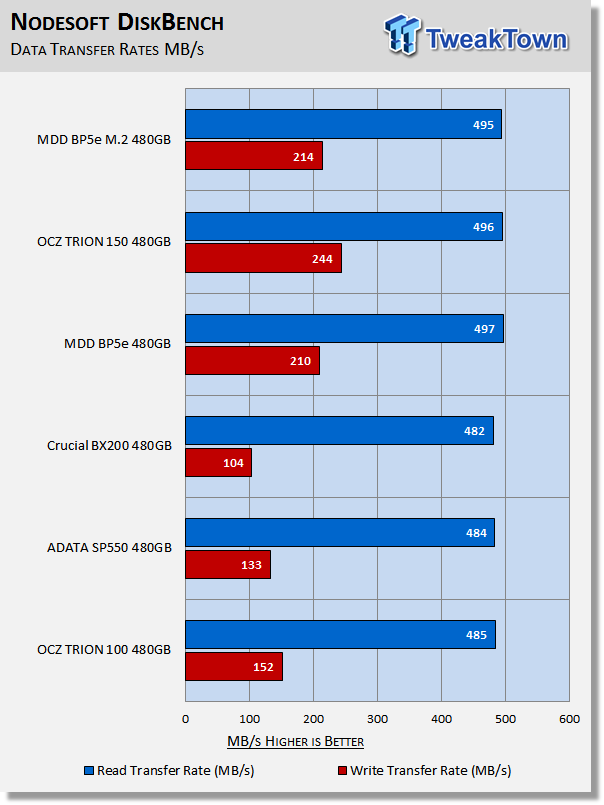
When evaluating planar-based TLC SSDs, we look to the write transfer rates with extra scrutiny. Look at the sustained write transfer rates of the BX200 and the SP550. This is THE reason why we've never rewarded an SM2256-powered SSD with a TweakTown recommendation. As we've stated many times, if any SSD cannot deliver sustained write transfer rates that can at least match that of a high-performance mechanical HDD, then it isn't a drive worth spending money on.
Benchmarks (Secondary Volume) - PCMark 8 Extended
Futuremark PCMark 8 Extended
Heavy Workload Model
PCMark 8's consistency test simulates an extended duration heavy workload environment. PCMark 8 has built-in, command line executed storage testing. The PCMark 8 Consistency test measures the performance consistency and the degradation tendency of a storage system.
The Storage test workloads are repeated. Between each repetition, the storage system is bombarded with a usage that causes degraded drive performance. In the first part of the test, the cycle continues until a steady degraded level of performance has been reached. (Steady State)
In the second part, the recovery of the system is tested by allowing the system to idle and measuring the performance after 5-minute long intervals. (Internal drive maintenance: Garbage Collection (GC)) The test reports the performance level at the start, the degraded steady-state, and the recovered state, as well as the number of iterations required to reach the degraded state and the recovered state.
We feel Futuremark's Consistency Test is the best test ever devised to show the true performance of solid state storage in an extended duration heavy workload environment. This test takes on average 13 to 17 hours to complete and writes somewhere between 450GB and 14,000GB of test data depending on the drive. If you want to know what an SSDs steady state performance is going to look like during a heavy workload, this test will show you.
Here's a breakdown of Futuremark's Consistency Test:
Precondition phase:
1. Write to the drive sequentially through up to the reported capacity with random data.
2. Write the drive through a second time (to take care of overprovisioning).
Degradation phase:
1. Run writes of random size between 8*512 and 2048*512 bytes on random offsets for 10 minutes.
2. Run performance test (one pass only).
3. Repeat 1 and 2 for 8 times, and on each pass increase the duration of random writes by 5 minutes.
Steady state phase:
1. Run writes of random size between 8*512 and 2048*512 bytes on random offsets for 50 minutes.
2. Run performance test (one pass only).
3. Repeat 1 and 2 for 5 times.
Recovery phase:
1. Idle for 5 minutes.
2. Run performance test (one pass only).
3. Repeat 1 and 2 for 5 times.
Storage Bandwidth
PCMark 8's Consistency test provides a ton of data output that we use to judge a drive's performance.
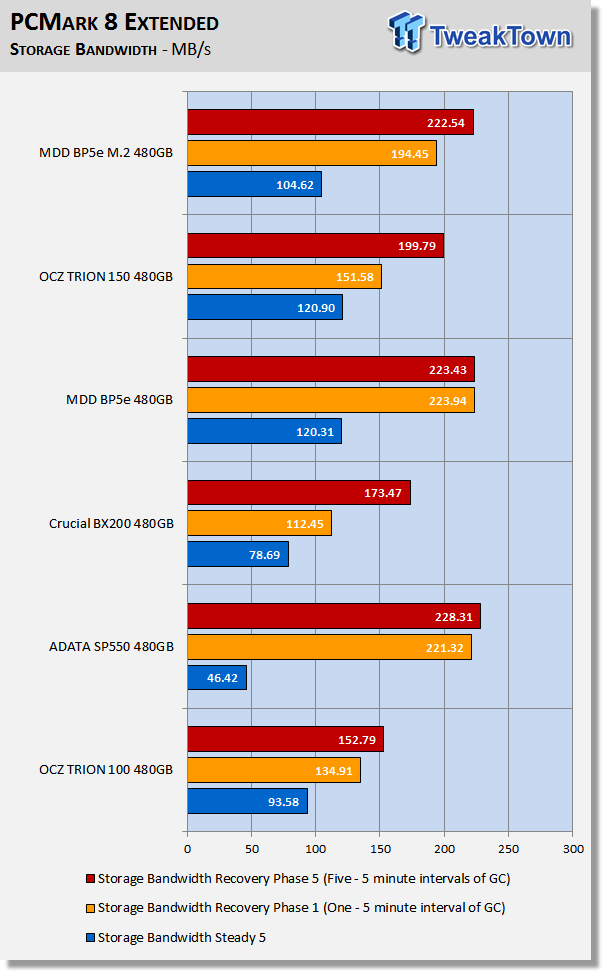
We consider steady state bandwidth (the blue bar) our test that carries the most weight in ranking a drive/arrays heavy workload performance. Performance after Garbage Collection (GC) (the orange and red bars) is what we consider the second most important consideration when ranking a drive's performance. Trace-based steady state testing is where true high performing SSDs are separated from the rest of the pack.
This time, the cased BP5e has the upper hand over the M.2 model. More parallelism wins out in this test. We can also point to the steady state results of this test as to another reason why we prefer S10-powered SSDs over SM2256-powered SSDs. ADATA's SP550 is no match for steady state workloads of this nature.

We chart our test subject's storage bandwidth as reported at each of the test's 18 trace iterations. This gives us a good visual perspective of how our test subjects perform as testing progresses. This chart sheds more light on how the drives perform as they progress through the testing phases.
Total Access Time (Latency)
We chart the total time the disk is accessed as reported at each of the test's 18 trace iterations.
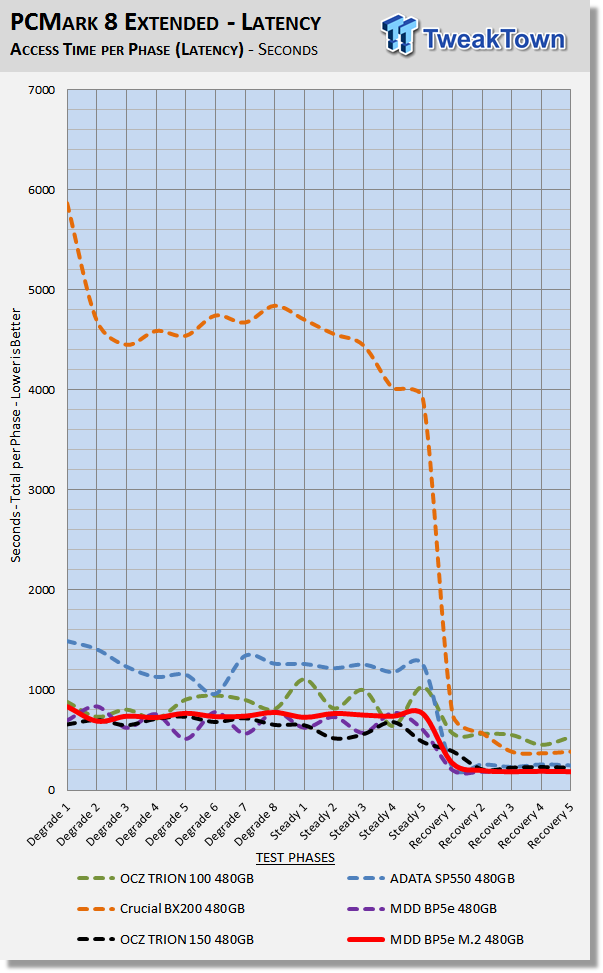
Low latency translates to the real-world as snappiness. S10-powered SSDs are very responsive; this is one of the reasons why we like Phison-controlled SSDs.
Disk Busy Time
Disk Busy Time is how long the disk is busy working. We chart the total time the disk is working as reported at each of the tests 18 trace iterations.
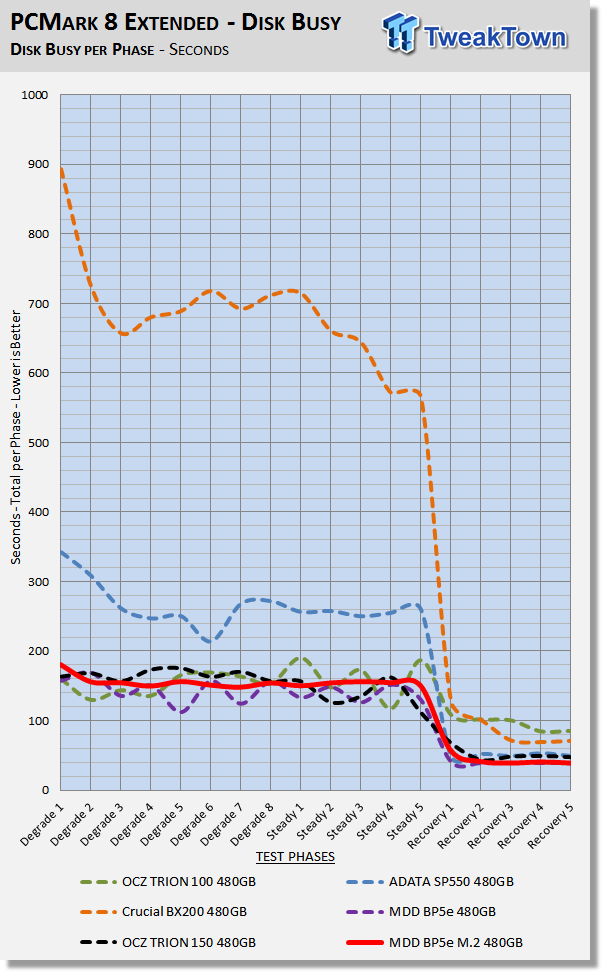
When latency is low, disk busy time is low as well.
Data Written
We measure the total amount of random data that our test drive/array is capable of writing during the degradation phases of the consistency test. Pre-conditioning data is not included in the total. The total combined time that degradation data is written to the drive/array is 470 minutes. This can be very telling. The better a drive/array can process a continuous stream of random data; the more data will be written.
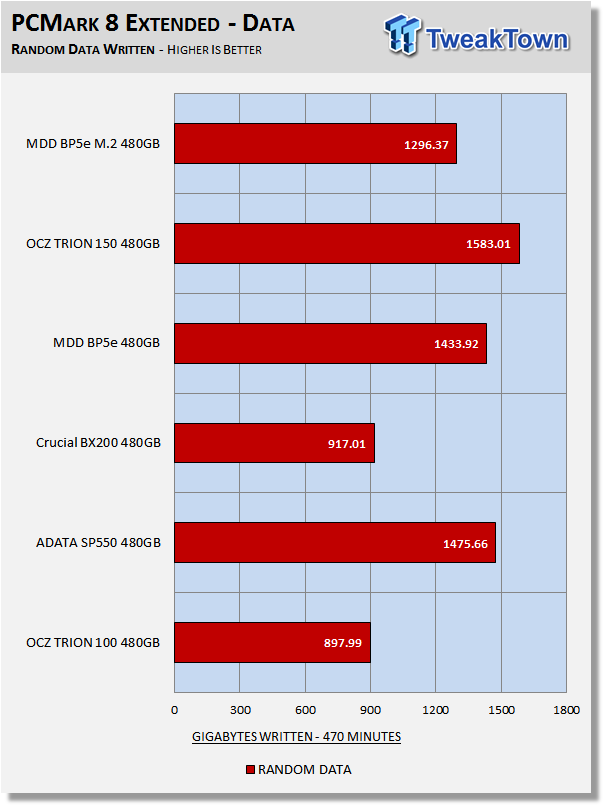
Overprovisioning and write latency are the biggest factors that determine the outcome of this portion of the test. Parallelism again wins out for the cased BP5e in comparison the the M.2 model.
Benchmarks (Secondary Volume) - 70/30 Mixed Workload
70/30 Mixed Workload Test (Sledgehammer)
Version and / or Patch Used: Iometer 2014
Heavy Workload Model
This test hammers a drive so hard we've dubbed it "Sledgehammer". Our 70/30 Mixed Workload test is designed to simulate a heavy-duty enthusiast/workstation steady-state environment. We feel that a mix of 70% read/30% write, full random 4K transfers best represents this type of user environment. Our test allows us to see the drive enter into and reach a steady state as the test progresses.
Phase one of the test preconditions the drive for 1 hour with 128K sequential writes. Phase two of the test runs a 70% read/30% write, full random 4K transfer workload on the drive for 1 hour. We log and chart (phase two) IOPS data at 5-second intervals for 1 hour (720 data points). 60 data points = 5 minutes.
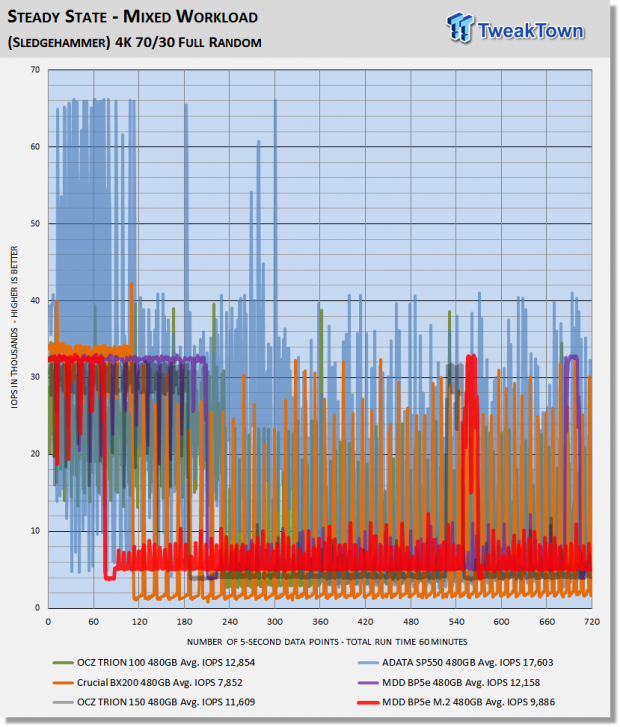
What we like about this test is that it reflects reality. Everything lines up, as it should. Consumer drives don't outperform Enterprise-Class SSDs that were designed for enterprise workloads. Consumer drives based on old technology are not outperforming modern Performance-Class SSDs, etc.
ADATA's SP550 continuously fills its pSLC layer and then flushes data to the NAND array. This is why there is so much variability in its performance. The S10-powered SSDs display much less variability, albeit with lower average performance.
Maxed-Out Performance (MOP)
This testing is just to see what the drive is capable of in an FOB (Fresh Out of Box) state under optimal conditions. We are utilizing Windows Server 2008 R2 64-bit for this testing. Same Hardware, just an OS change.

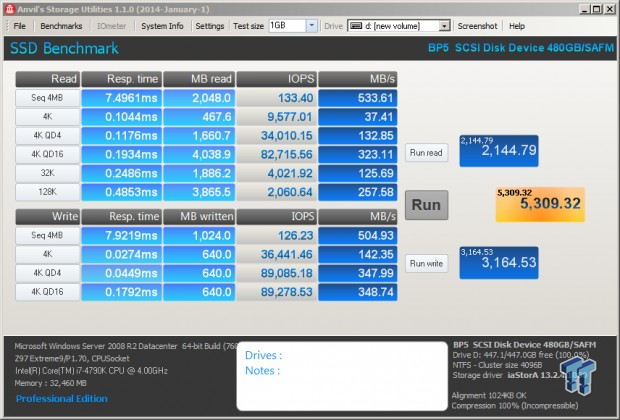
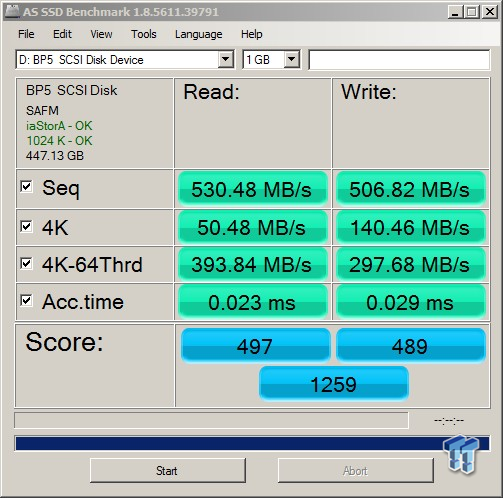
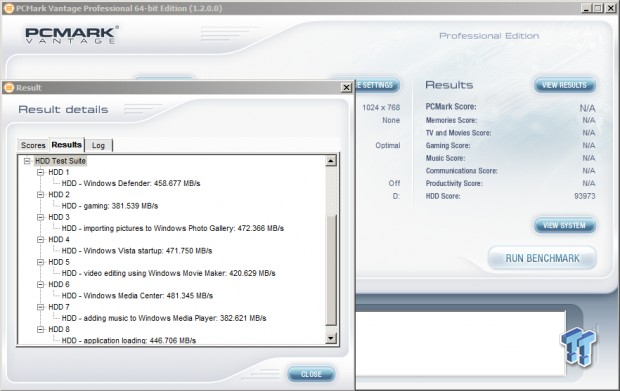
Final Thoughts
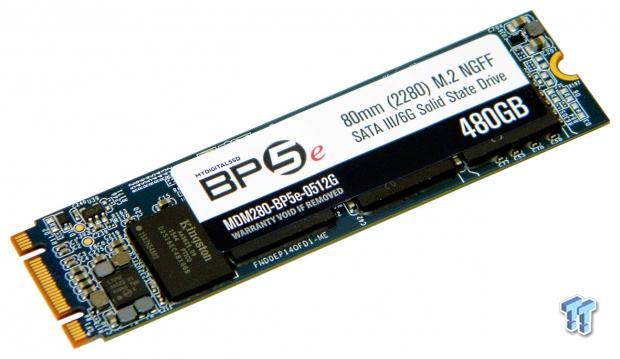
As it stands, we feel that if you are going to go with a super low-cost planar TLC SSD, the best bang for the buck comes in the form of S10-powered SSDs with Toshiba 15nm TLC flash arrays. Taking it a step further, we believe the M.2 form factor is the most desirable of all form factors. This leads us to the SSD we tested today. MDD's BP5e 480GB M.2 SATA III SSD checks all the boxes. S10 controller, Toshiba TLC flash, 480GB capacity, best form factor, and a super-low price point. Samsung's 750 EVO series is lurking around out there now, and is a better performing SSD, but its price point like that of the 850 EVO is significantly higher than the BP5e. Additionally, the 750 EVO isn't available in an M.2 version.
MDD's BP5e (the cased model) was the first non-Samsung planar TLC SSD to receive a TweakTown recommendation. With superior synthetic performance and acceptable sustained write transfer rates, MDD's BP5e impressed us with great performance and even more so with its super low price point. The M.2 version performs just as well and comes in a far more appealing form factor. There is something to be said for fast storage that doesn't require cabling or occupy a PCIe slot. The M.2 version costs about 14 bucks more than the cased version, but we feel that's a small price to pay for M.2 goodness.
Running MDD's BP5e M.2 SSD as our OS disk is a very pleasurable experience. The drive is responsive, boots like lightning, and handles multi-tasking with ease.
We really like what the MDD BP5e M.2 SATA III SSD has to offer. In fact, when it comes to choosing a super low-cost SSD, MDD's BP5e M.2 480GB is our new favorite drive. My Digital Discount's BP5e 480GB M.2 SATA III SSD is TweakTown recommended.
Pros:
- Low Cost
- Toshiba Flash
- Sequential Performance
- Most Appealing Form Factor
Cons:
- Moderate Workload Performance

